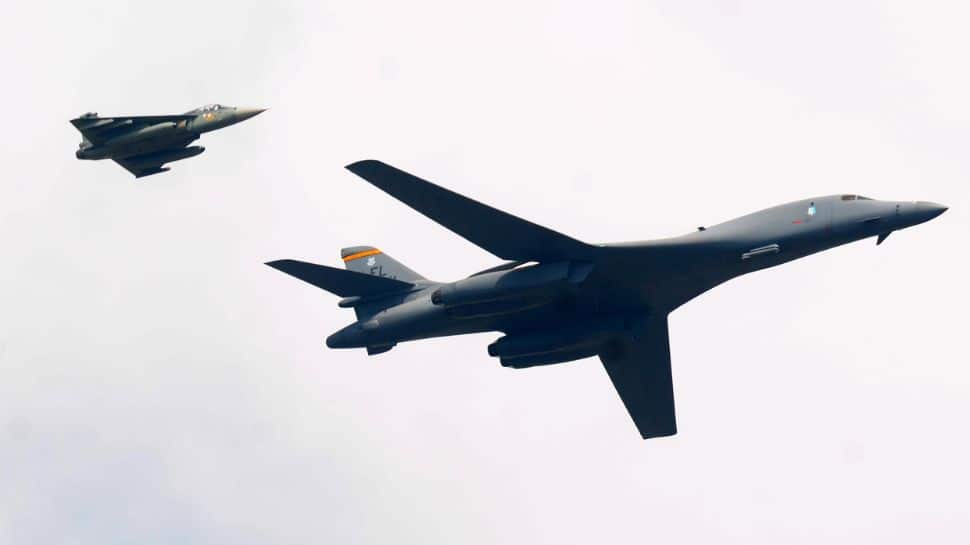The B-1B Lancer bomber stands as a formidable symbol of American airpower, renowned for its combination of speed, stealth, and payload capacity. Despite being in service for over four decades, this supersonic bomber continues to play a vital role in the U.S. Air Force’s strategic capabilities, proving that age has done little to diminish its effectiveness. With its ability to strike from extremely low altitudes, advanced radar systems, and unmatched maneuverability, the B-1B remains a lethal predator in modern aerial warfare, often described as a “ghost” that appears suddenly, delivers devastating strikes, and disappears before adversaries can respond.
One of the defining features of the B-1B is its revolutionary swing-wing design, which allows the bomber to alter its wing configuration mid-flight. During takeoff and slower speeds, the wings sweep forward to provide maximum lift, allowing the aircraft to ascend efficiently. When transitioning to high-speed or supersonic flight, the wings sweep back dramatically, reducing drag and enabling superior maneuverability. This unique design allows the Lancer to achieve blistering speeds and altitudes that challenge enemy air defenses, making it difficult to track and intercept. Complementing its aerodynamic advantages is the Structural Mode Control System (SMCS), which uses vanes and dampers to eliminate vibrations during demanding flight conditions, preserving the integrity of the airframe and enabling the bomber to operate reliably for decades without significant wear.
Powering this aerial behemoth are four General Electric F101-GE-102 turbofan engines equipped with afterburners. These engines propel the B-1B to speeds of up to Mach 1.2, surpassing the speed of sound and making it one of the fastest bombers in the world. Its massive fuel capacity allows it to conduct long-range missions, flying continent to continent without needing constant refueling. This endurance, combined with its payload capacity, makes the B-1B an unparalleled asset for delivering large volumes of ordnance deep into enemy territory.
What truly sets the B-1B apart in modern combat scenarios is its ability to operate at extremely low altitudes. Known as the “Death From Below,” this tactic allows the bomber to fly so close to the ground that enemy radar systems detect it only moments before ordnance is already being deployed. This low-altitude approach minimizes the bomber’s radar signature and makes it virtually invisible to traditional air defense systems. Additionally, the B-1B is equipped with advanced Doppler sensors and synthetic aperture radar, enabling it to “see” everything in its environment without being detected. This sensor suite allows the Lancer to navigate complex environments and identify targets with precision, even in adverse weather or challenging terrain.
The bomber’s armament is equally impressive. It can carry a diverse array of weapons, including hypersonic and long-range missiles, which allows it to engage targets from distances beyond the reach of enemy fighters and ground-based air defenses. This capability ensures that adversaries face significant difficulty in mounting effective counterattacks. Interceptors are often too slow to respond, surface-to-air missiles struggle to lock on, and air defense networks are rendered ineffective as the B-1B strikes swiftly and disappears before retaliation.
In recent weeks, the B-1B has been actively deployed in operations near Venezuelan waters and the Caribbean islands. These flights serve as a demonstration of American military reach and resolve, particularly in efforts to combat drug trafficking in the region. The presence of the Lancer in these sensitive areas sends a clear message to hostile regimes and criminal enterprises alike: no location is beyond the reach of U.S. airpower, and no defense system can guarantee safety from its strikes. This deployment underscores the ongoing relevance of the B-1B in contemporary military strategy, where its blend of speed, stealth, and firepower continues to shape the battlefield.
Despite the emergence of newer “next-generation” aircraft, the B-1B maintains a complementary role alongside fifth-generation fighters. While stealth fighters excel in air superiority and precision targeting, the Lancer’s massive payload and extended range provide a strategic advantage in sustained bombing campaigns and deep strike missions. Its ability to carry a wide variety of munitions, including conventional and nuclear weapons, makes it a versatile platform capable of adapting to evolving mission requirements.
The durability of the B-1B’s airframe and its sophisticated vibration control systems contribute to its longevity in service. Unlike many aircraft that suffer rapid degradation under the stresses of high-speed flight,

